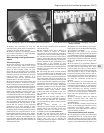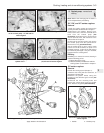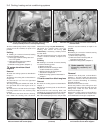
1 General information and
precautions
The cooling system is of pressurised type
incorporating an expansion bottle or expansion
tank according to model. The system includes
a front-mounted cross-flow radiator,
thermoswitch controlled electric cooling fan,
coolant pump and thermostat. The car interior
heater matrix is incorporated into the coolant
circuit with the interior air supply and
distribution being controlled by air flaps.
On XU and TU Series engines the coolant
pump is driven by the engine timing belt, but
on all other engines it is driven by the auxiliary
(alternator) drivebelt.
The cooling system functions in the
following way. After a cold start the
thermostat valve is shut and coolant
circulation is restricted to the engine and
heater matrix. When the coolant reaches the
normal engine operating temperature the
thermostat starts to open and coolant
circulation also flows through the radiator. The
engine temperature is then controlled by the
thermostat and the electric cooling fan
located on the front of the radiator.
Air conditioning is available as an option on
certain models and is described in Section 10.
Precautions
Warning: Do not attempt to
remove the expansion tank filler
cap, or to disturb any part of the
cooling system, while it or the
engine is hot, as there is a very great risk of
scalding. If the expansion tank filler cap
must be removed before the engine and
radiator have fully cooled down (even
though this is not recommended) the
pressure in the cooling system must first
be released. Cover the cap with a thick
layer of cloth, to avoid scalding, and slowly
unscrew the filler cap until a hissing sound
can be heard. When the hissing has
stopped, showing that pressure is
released, slowly unscrew the filler cap
further until it can be removed; if more
hissing sounds are heard, wait until they
have stopped before unscrewing the cap
completely. At all times, keep well away
from the filler opening.
Warning: Do not allow antifreeze
to come in contact with your
skin, or with the painted
surfaces of the vehicle. Rinse off
spills immediately with plenty of water.
Never leave antifreeze lying around in an
open container, or in a puddle in the
driveway or on the garage floor. Children
and pets are attracted by its sweet smell,
but antifreeze is fatal if ingested.
Warning: Refer to Section 10 for
precautions to be observed
when working on vehicles
equipped with air conditioning.
2 Cooling system hoses -
disconnection and renewal
1
Note: Refer to the warnings given in Section 1
of this Chapter before proceeding. Hoses
should only be disconnected once the engine
has cooled sufficiently to avoid scalding.
1 If the checks described in Chapter 1 reveal
a faulty hose, it must be renewed as follows.
2 First drain the cooling system (Chapter 1); if
the antifreeze is not due for renewal, the
drained coolant may be re-used, if it is
collected in a clean container.
Models with conventional hose
connections
3 To disconnect any hose, use a pair of pliers
to release the spring clamps (or a screwdriver
to slacken screw-type clamps), then move
them along the hose clear of the union.
Carefully work the hose off its stubs. The hoses
can be removed with relative ease when new -
on an older vehicle, they may have stuck.
4 If a hose proves to be difficult to remove, try
to release it by rotating it on its unions before
attempting to work it off. Gently prise the end
of the hose with a blunt instrument (such as a
flat-bladed screwdriver), but do not apply too
much force, and take care not to damage the
pipe stubs or hoses. Note in particular that the
radiator hose unions are fragile; do not use
excessive force when attempting to remove
the hoses.
5 When refitting a hose, first slide the clamps
onto the hose, then engage the hose with its
unions. Work the hose into position, then
check that the hose is settled correctly and is
properly routed. Slide each clip along the
hose until it is behind the union flared end,
before tightening it securely.
Models with CONRAD “click-on”
radiator hose connections
6 Some TU3FM engine models may be fitted
with pre-production “click-on” radiator hose
connections. These fittings were only fitted to
a limited number of vehicles, and have now
been discontinued in favour of conventional
hose clips.
7 The hose end fitting is retained by a large
circlip, which must be extracted before pulling
the hose out (see illustration).
8 When refitting, first fit the circlip into the
radiator fitting, placing the flat part in position
first, and bringing the ends into position one
at a time.
9 Ensure that the O-ring is in good condition,
and securely located in the hose end fitting. It
should not be necessary to lubricate the
O-ring to fit it, but if any form of lubrication is
used, the radiator must be refilled with fresh
coolant, to avoid contamination.
10 Align the hose end fitting with the three
lugs in the radiator connection, push firmly
into place, and check that the hose is secure
by pulling back on it.
All models
11 Refill the system with coolant (see
Chapter 1).
12 Check carefully for leaks as soon as
possible after disturbing any part of the
cooling system.
3 Antifreeze - general
information
Note: Refer to the warnings given in Section 1
of this Chapter before proceeding.
1 The cooling system should be filled with a
water/ethylene glycol-based antifreeze
solution, of a strength which will prevent
freezing down to at least -25°C, or lower if the
local climate requires it. Antifreeze also
provides protection against corrosion, and
increases the coolant boiling point. As with all
engines of aluminium construction, the
corrosion protection properties of the
antifreeze are critical. Only a top quality
antifreeze should be used in the system and
should never be mixed with different
antifreeze types.
2 The cooling system should be maintained
according to the schedule described in
Chapter 1. If antifreeze is used that is not to
Peugeot’s specification, old or contaminated
3•2 Cooling, heating and air conditioning systems
2.7 CONRAD “click-on” type radiator hose
connection
1 Radiator fitting
2 Retaining clip
3 O-ring
4 Hose end fitting
If all else fails, cut the hose
with a sharp knife, then slit it
so that it can be peeled off in
two pieces. Although this
may prove expensive if the hose is
otherwise undamaged, it is preferable
to buying a new radiator.
If the hose is stiff, use a little
soapy water as a lubricant,
or soften the hose by
soaking it in hot water. Do
not use oil or grease, which may attack
the rubber.


















